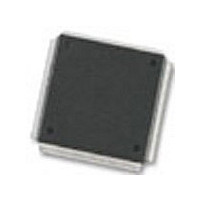MC68376BAMFT20 Freescale Semiconductor, MC68376BAMFT20 Datasheet - Page 226

MC68376BAMFT20
Manufacturer Part Number
MC68376BAMFT20
Description
Manufacturer
Freescale Semiconductor
Datasheet
1.MC68376BAMFT20.pdf
(434 pages)
Specifications of MC68376BAMFT20
Cpu Family
68K/M683xx
Device Core
ColdFire
Device Core Size
32b
Frequency (max)
20MHz
Interface Type
QSPI/SCI
Program Memory Type
ROM
Program Memory Size
8KB
Total Internal Ram Size
7.5KB
# I/os (max)
18
Number Of Timers - General Purpose
2
Operating Supply Voltage (typ)
5V
Operating Supply Voltage (max)
5.25V
Operating Supply Voltage (min)
4.75V
On-chip Adc
16-chx10-bit
Instruction Set Architecture
RISC
Operating Temp Range
-40C to 125C
Operating Temperature Classification
Automotive
Mounting
Surface Mount
Pin Count
160
Package Type
PQFP
Lead Free Status / Rohs Status
Not Compliant
Available stocks
Company
Part Number
Manufacturer
Quantity
Price
Company:
Part Number:
MC68376BAMFT20
Manufacturer:
FREESCAL
Quantity:
245
- Current page: 226 of 434
- Download datasheet (7Mb)
10.7.7 MCSM Registers
10.8 Double-Action Submodule (DASM)
10-10
MOTOROLA
The MCSM contains a status/interrupt/control register, a counter, and a modulus latch.
All unused bits and reserved address locations return zero when read. Writes to un-
used bits and reserved address locations have no effect. The CTM4 contains three
MCSMs, each with its own set of registers. Refer to D.7.8 MCSM Status/Interrupt/
Control Registers, D.7.9 MCSM Counter Registers, and D.7.10 MCSM Modulus
Latch Registers for information concerning MCSM register and bit descriptions.
The double-action submodule (DASM) allows two 16-bit input capture or two 16-bit
output compare functions to occur automatically without software intervention. The
input edge detector can be programmed to trigger the capture function on user-
specified edges. The output flip flop can be set by one of the output compare functions,
and reset by the other one. Interrupt requests can optionally be generated by the input
capture and the output compare functions. The user can select one of two incoming
time bases for the input capture and output compare functions.
Six operating modes allow the DASM input capture and output compare functions to
perform pulse width measurement, period measurement, single pulse generation, and
continuous pulse width modulation, as well as standard input capture and output com-
pare. The DASM can also function as a single I/O pin.
DASM operating mode is determined by the mode select field (MODE[3:0]) in the
DASM status/interrupt/control register (DASMSIC). Table 10-2 shows the different
DASM operating modes.
The DASM is composed of two timing channels (A and B), an output flip-flop, an input
edge detector, some control logic and an interrupt interface. All control and status bits
are contained in DASMSIC.
Channel A consists of one 16-bit data register and one 16-bit comparator. To the user,
channel B also appears to consist of one 16-bit data register and one 16-bit compar-
MODE[3:0]
0000
0001
0010
0011
0100
0101
0110
0111
1xxx
OPWM
OCAB
IPWM
Mode
OCB
IPM
DIS
IC
—
—
Disabled — Input pin is high impedance; IN gives state of input pin
Input pulse width measurement — Capture on leading edge and the trailing edge
of an input pulse
Input period measurement — Capture two consecutive rising/falling edges
Input capture — Capture when the designated edge is detected
Output compare, flag set on B compare — Generate leading and trailing edges of
an output pulse and set the flag
Output compare, flag set on A and B compare — Generate leading and trailing
edges of an output pulse and set the flag
Reserved
Reserved
Output pulse width modulation — Generate continuous PWM output with 7, 9, 11,
12, 13, 14, 15, or 16 bits of resolution
Table 10-2 DASM Modes of Operation
CONFIGURABLE TIMER MODULE 4
Description of Mode
USER’S MANUAL
MC68336/376
Related parts for MC68376BAMFT20
Image
Part Number
Description
Manufacturer
Datasheet
Request
R
Part Number:
Description:
Manufacturer:
Freescale Semiconductor, Inc
Datasheet:
Part Number:
Description:
Manufacturer:
Freescale Semiconductor, Inc
Datasheet:
Part Number:
Description:
Manufacturer:
Freescale Semiconductor, Inc
Datasheet:
Part Number:
Description:
Manufacturer:
Freescale Semiconductor, Inc
Datasheet:
Part Number:
Description:
Manufacturer:
Freescale Semiconductor, Inc
Datasheet:
Part Number:
Description:
Manufacturer:
Freescale Semiconductor, Inc
Datasheet:
Part Number:
Description:
Manufacturer:
Freescale Semiconductor, Inc
Datasheet:
Part Number:
Description:
Manufacturer:
Freescale Semiconductor, Inc
Datasheet:
Part Number:
Description:
Manufacturer:
Freescale Semiconductor, Inc
Datasheet:
Part Number:
Description:
Manufacturer:
Freescale Semiconductor, Inc
Datasheet:
Part Number:
Description:
Manufacturer:
Freescale Semiconductor, Inc
Datasheet:
Part Number:
Description:
Manufacturer:
Freescale Semiconductor, Inc
Datasheet:
Part Number:
Description:
Manufacturer:
Freescale Semiconductor, Inc
Datasheet:
Part Number:
Description:
Manufacturer:
Freescale Semiconductor, Inc
Datasheet:
Part Number:
Description:
Manufacturer:
Freescale Semiconductor, Inc
Datasheet:











